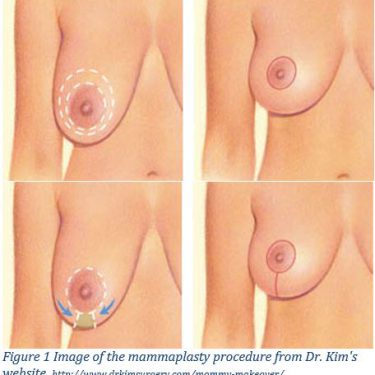After pregnancy some women opt to have the mommy makeover procedure, which involves a combine breast and abdominoplasty procedure. Click here to see real patients who underwent this procedure with Dr. John Kim. After pregnancy some women find that their skin becomes lax and can cause some undesirable cosmetic results1,2. These women are great candidates for the mommy makeover procedure. Postpartum there are changes that happen to the abdomen and breasts. The goal in the mommy makeover procedure is to create a firmer flatter abdomen as well as lifted well-shaped breasts2.
In the abdomen there are changes to the soft-tissue layers of skin fat and muscle2,3. The skin becomes more lax and can lead to loose excess skin hanging over the hips2,3. The diameter of the abdomen can also increase due to the changes in subcutaneous fat content, muscle relaxation, and sometimes an increase in the girth of the pelvic bone3. Furthermore there can be changes to the umbilicus making it convex due to an umbilical hernia3.
After pregnancy the breasts can take on a deflated appearance primarily due to a loss of the contour to the upper pole, areolar enlargement, and the development of a sagging appearance, called ptosis, which will cause the position of the nipple to point downward3,4.
These physical pregnancy-related changes might have an affect on a woman’s self esteem and body image1. In a 2014 study by Hodgkinson and colleagues found that a driver for this psychological unease is due to the discrepancy between a woman’s perception of her body image before.
A combination surgery such as the mommy makeover has some risks, which are inherent to undergoing any surgery. In the mommy makeover procedure the operation at the abdomen does not necessarily impact the breast2,3. Stevens and colleagues found that there was no increase in complications when comparing an abdominoplasty and a combined breast surgery and abdominoplasty procedure5. In a recent literature review Matarasso and colleagues found that it is 1.5 times more common for abdominoplasty procedures to be performed concurrently with another, and is supported from a report published by the American Association for Accreditation of Ambulatory Surgery Facilities3,6.
To learn more about the procedure make an appointment for a consultation with Dr. John Kim.
1. Hodgkinson, E. L., Smith, D. M., & Wittkowski, A. (2014). Women’s experiences of their pregnancy and postpartum body image: a systematic review and meta-synthesis. BMC pregnancy and childbirth, 14(1), 330.
2. Matarasso, A., & Smith, D. M. (2015). Strategies for Aesthetic Reshaping of the Postpartum Patient. Plastic and reconstructive surgery, 136(2), 245-257.
3. Matarasso, A., & Smith, D. M. (2015). Combined breast surgery and abdominoplasty: strategies for success. Plastic and reconstructive surgery, 135(5), 849e-860e.
4. Rinker, B., Veneracion, M., & Walsh, C. P. (2008). The effect of breastfeeding on breast aesthetics. Aesthetic Surgery Journal, 28(5), 534-537.
5. Stevens, W. G., Cohen, R., Vath, S. D., Stoker, D. A., & Hirsch, E. M. (2006). Is it safe to combine abdominoplasty with elective breast surgery? A review of 151 consecutive cases. Plastic and reconstructive surgery, 118(1), 207-212.
6. Chaput, B., Bertheuil, N., Alet, J. M., Bodin, F., de Bonnecaze, G., & Michot, A. (2016). Combined Abdominoplasty and Breast Surgery versus Isolated Abdominoplasty: Results of a Systematic Review. Plastic and reconstructive surgery, 137(1), 248e-249e.

